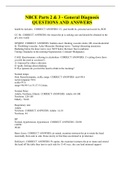Exam (elaborations)
NBCE Parts 2 & 3 - General Diagnosis QUESTIONS AND ANSWERS
- Course
- Institution
health hx includes: CORRECT ANSWERS: CC, past health hx, personal and social hx, ROS CC Hx CORRECT ANSWERS: the reason the pt is seeking care and should be obtained in the pt's own words OPQRST CORRECT ANSWERS: Sudden onset: thinking vascular stroke, MI, musculoskeletal Q: Throbbing=vascu...
[Show more]



